#hand controls
Explore tagged Tumblr posts
Text
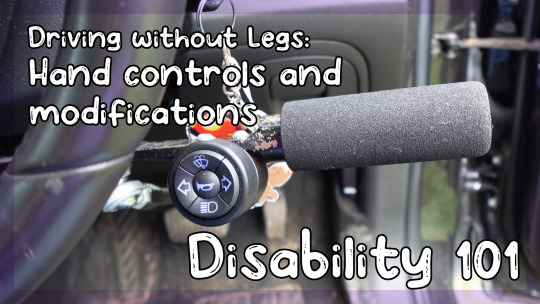
[ID: A photo of a mechanical push-pull hand control system, with "Driving without legs: Hand controls and modifications" "Disability 101" in white bubble text. /End ID]
One really common assumption I see about people who's disabilities effect their legs, such as leg amputations, spinal injuries or joint dysplasia, is that we can't drive. It's a common enough assumption that it makes its way into media portrayals of these kinds of disability all the time, though often in very subtle ways that are hard to directly point to, but noticeable once you know what to look for, or rather, what's missing. It's also an assumption I see come up more directly in the replies and reblogs to a lot of my content more often than I expected it too, and almost never as a direct question, but as statements that are part of a separate point. "My character is in a wheelchair so they need to catch the bus..." or "My leg amputee is missing the leg they need to drive so their friend/family member has to drive them to the place where the plot happens..."
but the thing is, It's a misconception! Having a disability that effects your legs or even arms in some cases (or results in you having none at all) doesn't stop you from being able to drive, at least not on it's own. It's not even a barrier to driving other kinds of vehicles, like motorcycles, aeroplanes or heavy machinery, and that's because of a type of assistive technology called vehicle modifications.
I've chosen to make this a disability 101 post, mostly because it is just kind of general disability-awareness content, even if I am focusing mostly on authors and creatives, but also because finding resources about this topic can be genuinely difficult if you don't know the names of the modifications or devices, so I've provided some resources throughout (and at the end in the sources section) that could be helpful for disabled people who are interested in getting these kinds of modifications themselves.
I do want to give a quick disclaimer before getting into this though, that I just have modifications, I'm not a mechanic or an expert on how they work, nor am I an expert of cars and other vehicles. Like anything, be sure to do your own research and fact check anything you see here, especially if the more technical stuff is relevant to you and/or your writing.
Ok, with that out of the way, let's get into it!
Cars
Lets start by talking about the vehicle modifications available for cars, trucks and other similar vehicles. For the sake of simplicity, I'm going to be referring to anything with more than 4 wheels collectively as "cars" but know this includes everything from actual cars, to trucks, to even road-trains.
Control Modifications
The most common type of control modification you'll typically see are called "hand controls" and there's dozens of types available for cars. How they do it changes, but they all work by taking the parts of a vehicle that are controlled with your feet, and make them controllable with your hands in some way.
The most common version of this, and the type I use, is called a "push-pull hand control". It works by replacing the foot pedals in (usually automatic) cars with a bar which sticks out from the side of the steering wheel that can be pushed forwards to apply the break, and pulled towards you to accelerate. This is the set-up I have in my car.
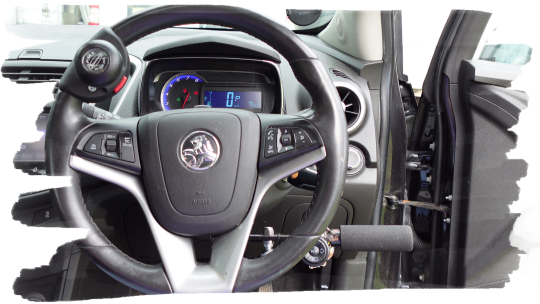
[ID: A photo of the interior of a holden car showing the steering wheel and dashboard. On the top left of the steering wheel is a round door-knob shaped grip assist, and on the bottom left is the bar of a hand control sticking out from behind the wheel. The bar has a foam grip on they end, and a circular control buttons for the blinkers, horn, headlights and windscreen wipers, though the top button is obscured by the steering wheel./End ID]
One way to set this up is done by attaching a long mechanism or pole under the steering column that physically pushes down on the pedals for you when you push or pull on the control bar. This is the type that I have, and as I understand, it's one of the cheaper ways to do it.
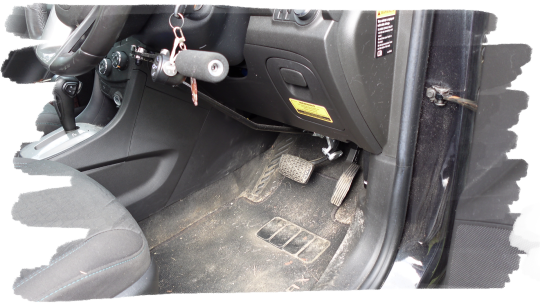
[ID: Another photo of the interior of the same car, this time showing the area where the driver's legs are supposed to go, which is covered in a lot of dust, the pedals and steering wheel. The hand control bar is fixed under the steering wheel, and a long metal rod connects the control bar to the pedals. /End ID]
(also please excuse the dirt, I live on a farm and it's been raining, so avoiding mud and dirt is impossible right now)
There are also versions of this systems that bypass the pedals entirely and connect the control bar to the car's internal systems. This is more commonly seen in electric vehicles or in cars that are being used by people with little to no control of their legs who might be at risk of pressing the pedals accidently - in which case, the pedals are also modified so they can be either folded up or shut off when the hand controls are in use, and then folded back down or turned back on when someone without a leg disability wants to drive.
There is also portable hand controls, which are very similar to permanent push-pull systems, but can be attached to almost any automatic car and removed as needed. Most I've seen have clamps that attach to the pedals, two adjustable poles, connected by a bar at the top, similar to push-pulls that essentially act as levers to press the pedals, and many are connected to the steering wheel via a Velcro strap. these are by far the cheapest and overall most flexible option, but they also happen to be mostly illegal where I live, so I've never actually seen them used in person. Technically, they can be used under very specific conditions here, but I've never met anyone who had them legally. Most people I know who tried to get approved were rejected. For everyone who doesn't live in or isn't writing a story set in NSW Australia though, Diamond Garrette has a demonstration of how they work on her YouTube channel, which I suggest checking out if you want to know more about them!
This isn't the only way the controls can be set up for the acceleration and breaking though. Other common variations include an over-ring control, trigger controls or joystick controls. In trigger hand controls, you still have a bar that extends out from the steering wheel that you push forward to break, but the accelerator is controlled using a trigger-like button underneath, similar to the accelerator on a motorbike. Joystick controls allow a driver to control steering and acceleration through a joystick (including sometimes the joystick built into the driver's power chair), and are usually a small part of larger modification systems. Over-ring hand controls, also called push-rings, are a type of control where the accelerator is tied to a ring that sits either over the top of the steering wheel, or just behind it, and you either use your thumbs to press down on it while you drive, or your fingers to pull it towards you if it's placed behind. The brake can either be another bar you push away from yourself like the others, or grip that sits beside the wheel that can either be pushed forward or squeezed in towards the wheel. If you'd like a demonstration for how over-rings work, Des Gosling Mobility has a demonstration on their youtube page! Trigger, joystick and over-ring controls are all often used by people who's disabilities effect their arms and legs, and who might have more difficulty with the heavier push-pull bar.
Because one of your hands will usually be occupied with most of these methods though (with the only exception being the over-ring and portable controls), many hand controls also have a second set of blinkers (indicators) controlled by buttons or a small flickable switch on either the hand control itself or a different location like the head-rest for easier access. While not as common, many also include extra buttons for the horn, windscreen wipers and headlights. On mine, I can control all of these "extras" through a small control pad attached to the bar, though only the blinker buttons and horn are actually connected (all the others cost extra).
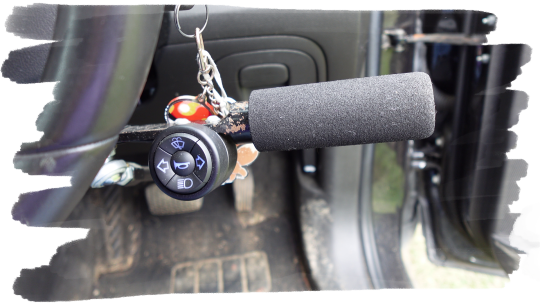
[ID: A close-up of my hand control, described earlier, to show the buttons. /End ID]
Another thing you'll often see on cars with hand-controls is either a spinner knob or some other style of grip assist on the steering wheel itself. Spinner knobs - which you can see in the first photo on this post, usually look like a door-knob attached to the top left or right side of the wheel (depending on what side of the road you drive on) that allow you to turn easier with your remaining hand, but other options include tri-rod spinners (which are mostly the same, but with three rods the user can place their hand and wrist on if they have problems with their grip) and joystick controls, which I described earlier.
I mentioned before that most of these hand-controls are mainly used in automatic cars, and that's because manual transmissions add some extra complications that, honestly, most people I know just prefer to avoid. That's not to say hand controls are only for automatic cars though, they just aren't as popular due to the extra hassle it brings. One option I am aware of is called the "duck clutch" which is a small leaver installed on the back of the gear-stick that lets you control the clutch pedal. This video from Problem Management Engineering shows how it works, though the person in their video still uses their foot for the accelerator instead of a hand controlled accelerator/break.
There are many other types of control modifications outside of these, including alternate-side foot pedals for drivers who don't have (or can't use) the leg they'd need to reach the accelerator, pedal extensions for people with dwarfism, or chin controls for people with no use of their (or no) arms. It's always a good idea to check and see if there are options available for people with you/your character's disability before making the assumption that they can't drive at all. Obviously, not every disability can be accommodated behind the wheel. For example, some autistic people struggle with the sensory processing and fast decision making needed for driving, and no amount of modification can help with that. Conditions like blindness and dementia are also pretty sure-fire disqualifiers once they reach a certain point (as both these disabilities exist on spectrums), but it's always worth checking if you've never been told for sure, especially if you are not disabled yourself.
Modifications for access
Another common kind of modification you see in cars for disabled people help them get in and out, as well as occasionally where and how they sit.
larger vehicles like vans have the most options available. My previous work vehicle (owned by a disability organisation with mostly disabled employees) for example had a large sliding door on the side that you could open to reveal a small lift. When not in use, it would fold up and sit against the door and when we needed to get in or out, you'd open the sliding door and put the lift in the "open" position, and it would lift you up to be level with the van floor so you could just roll in, or lower you down to the ground to let you out. It was a converted tradie van (a big white van usually used by electricians and other tradesmen to carry large amounts of tools and equipment) that had the back seats and a lot of the interior torn out, so you could take your chair all the way up to the driver or passenger seats and just transfer in, and I've seen similar set-ups with the lift coming out of the back as well. The major downside of these kinds of modifications, is that they require a lot of space, both in and outside of the vehicle. I dreaded taking the work van anywhere other than our planned destinations because finding parking spaces large enough for the lift to fully extend (about a metre, if I remember right) was a nightmare - though many places now have parking spots next to the accessible spaces that are kept empty specifically to help with that (if you've ever seen a parking space with stripes painted over it, that's what they're for).
Some vans can also have small fold-out ramps instead of lifts, which are a lot cheaper and don't require a power supply, but these tend to only be good if your van is low enough to the ground to keep the ramp small, otherwise getting in and out becomes a challenge. This is the approach I see used the most in wheelchair accessible taxis too.
As for the seating in vans, some people are able to get the driver's seat modified to spin around, making getting in and out of the driver's seat easier. I've also seen this in some cars and trucks, where the seat can rotate outwards to make transferring easier, or in some trucks that are higher off the ground, the seat can come out and be lowered, and then lift the driver back into the truck. While less common, I have also seen a few vans that allow wheelchair users to push directly up to the steering wheel and drive from their chair once it's secured, such as Problem Management Engineering Spacedrive system (The video linked here also contains a demonstration of a joystick control modification).
Some smaller cars and trucks can also have chair lifts installed that store mobility aids like wheelchairs either on the top of the car or, if it's a ute (a truck with a bed on the back) in the open bed.
Getting in and out without modification
Not everyone has these kinds of modification though. In fact, most manual wheelchair users I know don't have any seating or access modifications at all. For people with mobility aids like manual wheelchairs, getting in and out can be done without modifying the car in a few ways:
If someone is able to walk a little bit, they may put their wheelchair (or other mobility aid like a walker) in the boot (trunk) of their car, or on the back seat if they don't have the boot space. If their wheelchair folds, this makes it easier, but even non-folding, rigid-frame wheelchairs can fit in most car boots by taking off the wheels. If, like me, you have a car with a tiny boot where that's really not an option, many people will slide their wheelchairs onto the back seat of the car instead. Usually, this is done by putting the footplate of the chair where a person's legs would sit, and sitting the frame on the seat with the backrest up against the car seat backrest. It kind of looks like a weird booster seat once it's in. After that, wheels sit on-top of the seat. This even works with tiny cars! If a human can fit, most wheelchairs can too.
But what if they can't walk at all? well, that's a bit trickier, but its still doable for a lot of people. If we're travelling with someone, we just get them to do the steps I mentioned before, but if we are on our own, most wheelchair users I know (and myself) will get into the driver's seat, take the wheels off our wheelchairs, put both the driver-side and passenger-side backrest as low as it will go so they're both basically laying down, then pull the frame over ourselves and place it on the passenger seat in the same position as I described before. frame on the seat, footplate in the leg area and backrest up against the back of the car seat backrest once it's sat back upright - or, if you're cars a bit of a tighter fit like mine is, just put the frame and footrest on the passenger seat and leave the car backrest laying down. Then we put the wheels on top (if they fit, they usually don't) or on the back-seat. I'm a bit out of practice, since I usually have someone with me when I use the car, but this is a sped-up video showing my whole process:
[Video Description: A fast-forwarded video of Cy, a fat, white double leg amputee wearing a light purple shirt and blue jeans that cover their stumps as they get into their car, a small, black holden SUV. They start by putting their phone in the car door storage, transferring into the driver's seat and laying the seat all the way back. They then turn their wheelchair away from them and lift it so it is balancing on it's front footplate while they remove the wheels and put them to the side. With a bit of manoeuvring, they pull their wheelchair frame up, over their body, but it gets stuck, requiring them to fold down the handle bars so it will fit. They try again, but their chair gets stuck on something inside the car, out of view. Cy lowers the passenger seat to a laying down position and then continues to pull the wheelchair frame in, placing it on the seat. Lastly, they put the wheels on the back seat behind them. The video then fade-cuts to show them getting back out again, which is mostly the same process but in reverse, starting with the chair frame. They lift it over themself, then lean the chair forward so it is resting on it's footplate again, but the backrest is leaning up against the doors. They pull out one wheel from the backseat and re-attach it to the frame, then rotate the chair around and retrie the other wheel to put it back on the other side. Once both wheels are on and the chair is re-assembled, Cy then lifts their seat back up and transfers back into their wheelchair, and gives the camera a thumbs-up. /End Video Description].
Obviously though, this won't be an option for everyone. Not everyone has the strength or flexibility needed to get their wheelchairs in and over their bodies. I personally struggle with getting in and out of the car by myself because I have short arms and a big belly which gets in the way of getting my chair over the top of me to put it on the passenger seat. For people with joint dysplasia, doing this might risk something dislocating. Some power-chairs can weigh hundreds of kilograms, and no one, even able bodied, is lifting that on their own. and some wheelchairs are just physically too large to fit in a normal car, and that's when these access modifications can come into play.
Less-than-legal modifications
Sorry for yet another disclaimer, but just a reminder that this post is mostly for writing advice, which sometimes includes writing for characters who can't or don't care about doing everything correctly and by the book. It is not a guide on how to do this or encouragement to try. Do not, under any circumstances, try anything in this at home!
Sometimes, for reasons we'll talk about in a minute, “proper modifications” might not always be an option. Maybe you're writing someone who just doesn't care about the law that much, maybe they need to use an unmodified car in an emergency. Maybe its a zombie apocalypse and you can't be picky. Maybe your character just lives somewhere where the law isn't as strict. In those cases, know that disabled people have been Macgyver-ing and DIYing their own solutions for as long as cars have been a thing, regardless of what the laws have to say about it. Being in a rural area with a lot of space to drive off of public roads, I've also personally seen quite a few... creative solutions.
One especially common method to get around a lack of hand controls in cars for someone without the use of their legs, is a walking stick. Just a cheap one you can get from the shops, to help reach the pedals. I have a family friend who used to drive his old farm truck this way (again, never on public roads) and I may or may not have tried it as a teenager. It's definitely not a safe or convenient way to do it, but it's... a way, I suppose? I've also seen a few home-made spinner knobs and chair lifts to help people get in and out of trucks easier, known a few leg amputees and little people who have extended their own pedals in old farm cars so they can reach without things like prosthetics or orthotics.
humans are shockingly creative sometimes. But once again, please, do not try these at home.
Other things to be aware of
I mentioned before that disability alone doesn't always stop people from driving, but there are other things to consider for disabled drivers that you should be aware of if you're writing us (or if you're a disabled person wanting to get modifications yourself) either because they can create extra barriers, or they're just important to know.
Initially, I tried to make this section as generally applicable to people in different countries and with different disabilities as I could, but outside of the "cost" section, I don't really think that's possible unless I wanted to spend weeks researching and trying to get answers out of insurance companies and governments and this post is already really long. So instead, I think the best approach I can make on a limited timeframe is to talk about the barriers I've faced, or that people I know have faced, to kind of give you a general idea of what to look for in your own research. What barriers you or your characters face will change massively depending on your location and disability, but hopefully this will give you a stepping-off point.
Cost
So the first major barrier that a lot of disabled drivers face outside of their actual disabilities, is the cost of these modifications.
The hand controls in my personal car that I've been describing throughout the article are considered basic, and when I had to get them replaced in 2024 due to an accident, I was quoted $8,925 AUD (which is a little over $5,700 USD), just for the mechanical push-pull mechanism, blinkers and horn button, and this is pretty average in terms of price for this kind of system. I have seen them go for cheaper, for example, my first set of hand controls were second hand and it still cost around $2,500 AUD, but this was several years ago now. I think around 2016. prices for everything related to disability in Australia have skyrocketed since then.
I also happened to be working in the office the day the quote came in for the modification to my old workplace's vehicle when we first got it, (the one with the side access lift, which also had a push-pull hand control but no additional blinker/horn buttons and rotating seats) and we were told it would cost over $50,000 AUD to do all the modifications. I'm pretty confident this was also a discounted rate too, since our company had several modified vehicles and we always went to the same place for installation. Once again, this was a good number of years ago now, probably around 2018 at the latest.
Like a lot of disability aids, depending on where you live, either government-run healthcare programs, public insurance or private (usually health or car) insurance can sometimes either subsidise or cover the cost of modifications outright. However, this isn't always an option for everyone and a lot of people end up having to pay for their modifications (and all the other extra legal hoops they have to pay for, that I'll talk about soon) out-of-pocket.
In Australia, the NDIS (A disability-specific public insurance system) is generally considered to be responsible for covering vehicle modifications in the public sector, and on paper at least, they do. But like with most insurance companies, there's a million different conditions and "gotcha's" that let them get out of paying for them. My first set of hand controls were funded by them, but not without a substantial amount of arguing and a small army of both medical and mechanical experts to vouch for both me needing the modifications for my disability, and my car actually surviving long enough for it to be worthwhile paying for them. You see, at that point in time, if your car was less than 3 years old or had less than a certain number of kilometres on the odometer (I have no idea what it was, something ridiculously low), you could get your hand controls covered, mostly no problem. Statistically though, most people with disabilities severe enough to even qualify for these modifications, didn't have the money for a car that new due to systemic barriers. There was a bit of leeway though, as long as your car was less than 10 years old, you could sometimes get them covered regardless, so long as you could prove your car wasn't falling apart on the road already. Unfortunately, my car was from 2004. So... a little bit outside that window. Honestly, I don't know how we got it approved. Today, those rules are a bit different, they've extended the "usually fine" margin to 5 years OR if your car is still under a manufacturer's warranty, but the 10 year cut-off is much stricter than it used to be (because as we all know, after 10 years your car just starts to disintegrate, obviously).
There are also a bunch of other seemingly random things that can disqualify you from getting vehicle modifications covered, including "not being good value for money" or there being other services available (when I applied they originally tried to argue this with me, and suggested public transport was an option). Honestly, whether or not you get approved for them or not just seems to come down to who was working in the office at the NDIA that day and if they'd had their morning coffee when they saw your request. If you want to know more, this is the publicly-available outline the NDIS has. If you live in Australia and you're thinking of getting vehicle modifications yourself, it's worth a read, but be mindful it's never as simple in reality as it is in these kinds of outlines.
In Australia, private health insurance will cover it sometimes, and I know a few people who got theirs that way, though I don't know what the process is like. I do know private car insurance will also replace existing modifications if you're in an accident that destroyed your old ones, which is how I got my second set of modifications. Also after a lot of arguing. You see, in Australia, our disability anti-discrimination law, the DDA, does protect disability-related car modifications as essentials that can't be charged extra for, but that doesn't mean insurance companies won't try to get out of covering them if they can. Many will claim they don't have to cover the modifications unless you paid for "extras" to be insured too, and bet on customers not knowing that's against the law. Unfortunately, the DDA is a massive law and while most people know it exists, they don't know exactly what it covers and this lie ends up working. Even if a person does know it's illegal, if an insurance company refuses to budge once its pointed out to them, many disabled folks don't have the time, energy or money to actually hold them accountable in court, so they still get away with it, and another barrier is created, even if, legally, it's not supposed to.
From what I was able to find, in America, private insurance companies will sometimes cover the cost vehicle modifications (assuming you can even afford insurance to begin with) but even if you get them, another barrier arises in the form of insurance premiums. unlike the DDA, their ADA doesn't always protect the modifications as essentials. Because of that, it's not uncommon to have to pay more on car insurance if you do have them and want them covered, which presents a different kind of cost barrier and makes driving with them legally riskier.
Legal restrictions and getting "approved" for use
I mentioned this in passing before, but in order to get modifications for your vehicle, at least in Australia, you actually have to get "approved" by your state government to be able to use them at all. Also, in NSW, for control modifications like hand controls, once you're approved to use them, that's all you're allowed to use. This means, if you and your friend both own a car with different kinds of hand controls, you're not allowed to use the other person's car. This was actually the case for me and my previous roommate, she had an over-ring, while I had the push-pull mechanism. Legally, we couldn't drive each other's cars. Despite both having hand controls and being physically able to drive each other's cars, we weren't legally allowed to.
This is because in most places around the world, the modification of cars in general and specifically the use of alternate controls systems like hand controls are very heavily restricted for a variety of safety reasons (some of which are reasonable, and others... eh... not so much) - Even some US states forbid things like spinner knobs from being used without state government approval. Australia is... a little extra in this regard, to put it mildly, and their restrictions can be serious barriers all on their own.
Usually, to get approved to use modifications here, you have to go out with an Occupational therapist to test which type of modifications work for you. For control modifications specifically, once a best fit is found, this will be added as a condition to your licence, meaning you can now only drive with that style of control. This isn't too bad if you get your modifications covered by the NDIS or insurance, since they'll usually cover the cost of the OT as part of this, but if you're one of the unlucky people that can't get covered, you also have to pay for the OT, which can be thousands of dollars on top of the other costs.
Access to installation and maintenance
Another major barrier for a lot of disabled people who need these kinds of modifications is physical access to someone who can actually put them in and maintain them.
You see, not just any mechanic can install disability modifications, especially control modifications. You have to go to a specific type of engineer. The only exception to this rule, as far as I'm aware, is the portable hand control, which is a big part of the reason why they're banned in my state, as they can't be assumed to be safe.
Unfortunately, this is a pretty niche area of speciality, so there aren't a lot of options to get the installations done. There are only 8 in all of NSW (which has an area bigger than 3 times the entire UK), according to Australia's National Equipment Database, and the vast majority of them are in the Greater Sydney Region. This means, if you don't live near Sydney, you're out of luck for the most part, unless you can spare a few days to make the trip (since the installation can also take some time). Some companies do offer to come and get the vehicle for you, but not all, and even those that do, may not be able to come get it if you're 8+ hours away.
And that's just the installation. Thankfully, normal car maintenance still can be done by a general mechanic, even with modifications installed, but if anything happens to the modifications themselves, you normally have to go back to the person who installed them for repairs. Personally, I now live around 4 hours out of Sydney, and around Christmas, the wiring in my hand controls failed. It was a simple repair, but my partner and I had to go all the way back to Sydney for it, and we had a lot going on at the time, so we had no choice but to leave it for over a month. Meaning there was a whole month where I just couldn't drive.
Uneducated Law Enforcement
Ok, so this one is kind of a... luck of the draw situation and it's not a common barrier in my personal experience, but I also recognise that, as a white person who can still pass as cis if needed, my experience here won't be universal. Disabled people with intersecting identities such as POC and visibly queer folks, may have a substantially harder time with this.
Unfortunately, because disability modifications are not super common in the general public, it's not uncommon for police to have never seen them before. And when police don't know about something, that can become your problem very quickly. Most of the time, there's no issue, but I have been accused on two separate occasions of having "illegal racing modifications" in my car, because the police didn't know what a hand control was and jumped to that assumption (I'm not even sure what they would have been confusing them for, I've seen racing mods and they don't look anything like hand controls). I was also once told I'd have to get my car towed when on my way to get it checked by a mechanic for registration, because the officer didn't believe me that a regular mechanic could do it due to my hand controls, so obviously I must be lying and trying to drive my unregistered car around town (I don't know what the law is in other places, but here you are allowed to drive an unregistered vehicle to the mechanics if they know you’re coming). Both situations were pretty minor and were resolved quickly, but they could have easily been a lot worse if the officers decided not to believe me, or in the case of the second situation, they didn’t believe the mechanic who had to be called to convince the officer I was telling the truth.
Other Kinds of Vehicles and Modifications
Cars aren't the only vehicle you can modify to drive with a disability, they're just the most common! Honestly, each other vehicle was originally going to be it's own segment, but this post is already incredibly long, so here's just a quick overview of the modifications I know about for other vehicles!
Motorbikes and trikes often don't need much in the way of control modification for most riders, but many bikes can be modified to be easier to balance on or hold a wheelchair, either on the back or side, and trikes can be made to allow the rider to stay and ride from their wheelchair directly.
The laws for this are different everywhere, but in Australia and the UK, light aircraft can also be modified to be accessible to people with some physical disabilities, including wheelchair users with hand controls. Wheelies With Wings is a Melbourne based organisation the specialises in helping wheelchair users learn to fly . For those in the UK, Freedom of the Air offer similar services. Though as you might expect, there are some pretty substantial cost barriers involved for this.
I also know a few people who have also (legally) modified their farm equipment, like tractors or even heavy machinery, like bulldozers.
Pretty much anything can be modified. More often than not, if something can't be, it's usually more due to legal problems than it being physically impossible.
Conclusion
There's so many kinds of vehicle modifications out there, for all different kinds of vehicles, this is really just a general overview, so be sure to research what would be applicable to you or your characters
Sources
Over Ring Accelerator Demonstration
Driving With A Disability - Portable Hand Controls
Duck Hand-Operated Clutch System
NDIS vehicle mods PDF
Vehicle Modification Agents Vehicle Modification Agents Database
Wheelies With Wings Facebook page Link
Freedom of the Air Link
#writing disability with cy cyborg#disability 101#long post#writing disability#disability representation#hand controls#vehicle modifications#accessibility#accessibility modification#driving#disabled#disability
188 notes
·
View notes
Text
I’ve seen a few posts recently talking about how important it is for us to share our tips for dealing chronic illness with each other, and I’ve realized that as a freakishly avid community enthusiast, I’ve been falling down on the job. So, I present
Wellplacedbanana’s Ridiculously Long List of Tips for All Things Chronic Illness (Curated Over 8+ Years):
Infusion Centers
Headed to an infusion center to get that sweet sweet (expensive as hell) live-saving medication pumped directly into your veins? Here’s what I do.
Bring headphones or earplugs. Most infusion centers try to maintain a semblance of quiet for the patients, but it can get loud fast—beeping IVs, pulse ox monitors, loud families, codes. Some infusion centers do pods of multiple people and some do individual bays, so this can affect noise levels.
Drink lots of water before if you have to get an IV placed. Don’t worry too much about bringing a water bottle because they’ll give you one when you get there. (Of course, if you have something like POTS and need more intense hydration, bring the damn water bottle.) If you’re not hydrated and they can’t find a vein, they’ll call in the ultrasound tech, and they’ll bring the longest IV needle you’ve ever seen. It hurts. Drink water.
Bring a book or your Switch or something else to entertain you, but don’t expect to actually do it. I tried bringing papers to edit the first time because I was like “Oh it’s an hour and a half of uninterrupted free time. I can get so much done!” I was wrong. The nurses are constantly checking in for vitals, the unit can be loud, and I spent the whole time trying not to vomit everywhere. Different infusions will have different side affects. Knowing what yours might be will help you plan for what you want to bring. Knowing how long your infusion will be can also help. Most infusion centers have to keep you 20-45 minutes after your first dose of a new medication to make sure you don’t have an allergic reaction, so factor that into your time too.
If you’re in a pod with other patients who’re friendly and if you feel up to it, don’t be afraid to talk with them. Lots of them are lonely, bored, interested in other people, etc. I met an elderly Thai lady one time who had been there for three hours and would be there for another four AFTER I left. We talked about her husband and her kids, and she listened to me talk about punctuation as style in prose. It made me feel less alone in the medical system and helped distract me from the nausea.
Conversely, if you don’t want to interact with anyone, snap on those headphones and block everything out. The nurses will get your attention if they need you. Don’t worry about staying lucid. Your job is to get the infusion and do what’s best for you.
You can bring snacks if you want, but most units/centers will have something to munch on or can order you something from the cafeteria if you’re at a hospital. Also the medication and the smells in the unit always make me nauseous, so it’s kind of a waste for me to bother pulling together food before I leave. You can always eat before or plan to get something on the way back. Going through a drive thru to get something with protein is my go to.
If possible, schedule your next appointment while you’re there. I have to go every three months, so I schedule the next one while I’m there, and then I never have to make any fucking phone calls. Phone calls are the worst.
My last and most important tip: ask the nurses when you need something. Blankets, water, snacks, pain meds, the lights turned off. If they can’t do it, they’ll tell you. They’d rather have you ask and have to say no, then you be uncomfortable. Don’t suffer if there might be a solution.
Dealing with Shitty Doctors
There are shitty doctors everywhere, in every specialty and every hospital system. It sucks, and you can do your best to avoid them, but most chronically ill patients will have to put up with one at some point. Here are my suggestions:
If they’re refusing to acknowledge one of your symptoms is a problem (won’t order tests, won’t refer you out, won’t ask any questions), tell them it’s affect your Activities of Daily Living. ADLs are one of the ways doctors measure severity of symptoms and quality of life. ADLs are the absolutely essential things you need to do to be a functioning human: eat, shower, get dressed, brush your teeth. ADLs are a trigger word for most doctors. Physical therapists and occupational therapists were created specifically to help patients achieve their ADLs. If you’re having severe joint paint, say it’s affecting you’re ability to shower and dress in the morning. If you have intense fatigue, say you’re too tired all the time to cook food to eat or even brush your teeth before bed. Tell them your symptoms are affecting your quality of life and your ability to function daily. This won’t always work, but it’s a good starting place. (A side note: if you have have to submit an insurance appeal for something that was denied, citing ADLs as a reason to receive the treatment/medical equipment/doctors visit, will often spur them into action. Sometimes, it’ll just make them ask more questions, but questions are better than flat out denial. This was a very helpful tactic when I was trying to get my manual wheelchair approved. I told them I was unable to complete my ADLs and it was affecting my quality of life, and they eventually came around. It’s also important to remember that ADLs are only the most base tasks that you need to live. Driving, working, socializing—those aren’t included in ADLs, and insurance especially will laugh in your face if you try to say you need medical equipment for something like that.)
Lots of doctors, consciously or unconsciously, will judge how you’re actually feeling by your mood in an appointment. I had a pediatric neurologist who couldn’t be convinced that my pain was at an 8 because I would laugh with my mom in the waiting room. Eight months in, I started getting real quiet, not talking, crying when he talked, all that shit, and he was so fucking flummoxed. He was like “what changed?? Are you depressed??” And I had to remind him that I was thirteen with a severe shoulder inure that hurt every time I breathed. Doctors will judge you based on how you look and how you present. It’s horrible, but it’s true. Present to them in the way that represents what they’d expect to see for your symptoms.
Whatever you do, don’t say anything (or send any snappy messages) that might be considered aggressive until you are absolutely, 100% positive you will never ever have to see them again. I’ve had a few doctors that said ridiculously horrible things to me. It’s tempting to send them a message about how shitty they’ve been or how much they’ve hurt you, but it won’t help. Shitty doctors have fragile egos and they don’t like to be challenged. They won’t take this well, and they’ll mark you as attention seeking, emotional, mentally unstable—you name it. When your other doctors call to ask questions about symptoms, etc, they’ll start talking shit, and everything gets complicated. This might sound dramatic to anyone who hasn’t seen it happen, but honestly, the medical system abuses emotion and mental illness to discard patients that aren’t afraid to advocate for themselves, and this is one of the least immoral ways they do it.
Remember that you don’t owe your doctors anything (except basic human decency). If they ask you to do something and you can’t or don’t want to, don’t. My psychiatrist was really fixated on me getting a light box to cure my depression. I did Not want to do that, so I didn’t. Sometimes, your doctors won’t move on to further treatment or tests until you try it, but most of the time you can say, “that’s not something I’m able to do right now. Let’s explore further options,” and they’ll move on.
Remember that learning to advocate for yourself takes years of practice. Just do your best, and try not to blame yourself for the ways you get mistreated. Therapy is the best investment I’ve ever made for this. It’s helped me learn how to advocate and how to process medical trauma.
Medication
For gods sake, take the as needed medication when you have a migraine or if you’re nauseous. Don’t punish yourself.
This might seem like a no brainer, but if you’re traveling and you’re going to take your medication bottles with you, put them in a ziplock bag. They will definitely open in your suitcase, and you’ll have to pick Levothyroxine out of your socks.
If a medication gives you icky side effects, tell your doctor and ask if there’s something that doesn’t do that. For me personally, it’s hard to find medication that works at all, so I often get stuck with things that make me feel like shit. But it doesn’t hurt to ask. Sometimes new medications come out or they dig up old ones.
Some medications come in dissolvable tablets or suppositories. They’re not fun, but if you have trouble swallowing pills, this is a good way to go. Again, communicate with your doctor about these things. I know that there are Scopolamine patches for nausea too. I’ve never used them before, but it might be worth looking into if need easy nausea relief.
All Things Wheelchair
Man, wheelchairs suck, but they’re also amazing. If you find yourself using one, you’ll encounter a steep learning curve.
If you’re not super buff when you first start, it’ll seem impossible to go up even a slight incline. Your arms will get stronger the more you move around, but it might take time. I eventually bit the bullet and started doing personal training. I’m lucky that I can afford it, and I know it’s not an option for everyone, but if you can, find a trainer who won’t saying anything shitty and who’s willing to accommodate. I worked with a queer-owned gym to find someone I was comfortable with. We do upper body strength training, and it gives me a chance to move my body more often. I still can’t go up big hills, but I feel infinitely more mobile. Give yourself time to adjust to the new strain on your body, even if you don’t do training for it. You’ll be sore in the beginning. Ice and heat will be your friends after long days. If your wrists start hurting a lot, you’re not wheeling correctly, and you should ask your doctor for a referral to PT or OT. Oh and your hands will be fucked for the first few weeks. I bought special wheelchair gloves to try to combat this, but it just made it harder for me to maneuver. Now I only use the gloves if it’s cold, if I’m going down hills, or in the rain/snow. (But seriously, if you’re going down steep hills, use traction gloves.)
Learn to pop a wheelie as soon as possible. It’s such a helpful skill. If you get good enough, you’ll be able to get up over single steps and traverse shitty pavement.
If your wheelchair has a cushion, then it has a cushion cover. Wash it.
Time for the grossest part: cutting hair out of your caster wheels. I hate this. I hate it so much. It’s fucking disgusting, but you have to do it. It’ll fuck up your wheels and make it harder to maneuver. Also it’s just gross to have all that nasty hair hanging out by your feet. Get yourself a long pair of thin scissors and cut all that hair out every week or every two weeks. If you don’t have long hair or live with people who have long hair, then you might be able to wait longer. You should also sanitize your hand rims while you’re at it. Hand sanitizer or Clorox wipes are great for this.
You’ll notice that it’s fucking impossible to carry shopping baskets or suitcases if you use a manual chair. Some people try to balance them on their laps or wedge them onto their footplates, but it’s pretty precarious. I got these weird peg things that attach to the frame. You can place a basket or your bag on it and still keep your hands free. Here’s the link for the ones I got, but it depends on your make and model, so do some research and call some different companies before buying anything. Also, make sure to measure the distance between the two sides of your frame to make sure a basket will be able to balance on the two pegs. Your frame might be too wide for this. Mine is, but I bought a special basket to take to the store that’s wide enough to reach across.
Lots of people will offer to push you. Some won’t even offer; they’ll just grab on and take you in whatever direction. It’s insanely invasive and dehumanizing. Don’t be afraid to put on your breaks if someone does this. I can stand and take small steps, so sometime I just get up and stare at them. You can also buy covers for your handles that have spikes so people can’t grab them. I know some wheelchair users who like it when people offer to push them. That’s good too! Take the help if you want it. Just remember to prioritize your safety and comfort. I had a big debate with another disabled person about whether it was infantilizing for someone to offer to hold open the door for us. I’m firmly on the side that they can offer, and I can say no, and they can listen, and then we can both appreciate the moment of shared humanity between us. They did not agree. Disabled people fight and disagree all the time because we’re not all carbon copies of each other. That’s okay! Just be respectful.
Getting a customized manual wheelchair was one of the single most stressful things I had to deal with. Insurance doesn’t like to pay for them because it’s about 3-12k, depending on the specifications and add-ons. But it’s also been the most liberating thing I’ve done since getting my mobility stripped from me. I’m not sure how it works for everyone, but I got a referral from my doctor to a custom wheelchair company. From there, they took measurements, discussed needs, and showed me different models. It’s going to be really really difficult to know what you want the first time. There’s a lot of different brands and customizations, so do your research and talk in depth with whoever’s making your chair. Ultra lite rigid frames are my favorite because they’re usually only 15-40 pounds, and the wheels can come off to make it even lighter. However, rigid frames don’t fold together in the middle like classic manual wheelchairs that you might find at a hospital or get at a rental company. They can be difficult to fit in the backseat of a car or in some trunks, so make sure to measure any cars you ride in regularly. Some people prefer to have tilted wheels so they can turn easier. Some people don’t want anything to do with that. Depending on your mobility and the people in your life, you might choose not to add push handles to your chair. I added some to mine because I often get dizzy, and it’s helpful to have handles in case I need someone to push me out of the crosswalk or into the shade. People who are highly independent and extremely strong might not want push handles because they won’t need help up steep hills. I like my handles a lot; however, my chair back is shorter than a standard wheelchair because it helps increase range of motion when I’m wheeling, so my push handles are lower than normal, and anyone who wants to push me has to hunch a bit to reach. Again, do your research and talk to your rep before making final decisions. Some companies will let you test out the chairs they have on hand to see what you like. It’s important to work with a wheelchair company you really like because you’re literally putting you life in their hands. I’ve had better luck with smaller, locally-owned companies, but you can’t always get referrals there, and not every town has them. Here’s my tip to you: Numotion sucks ass. Avoid them. My branch of Numotion seems to be an outlier; I’ve had really good experiences with them. But most of the time, its impossible to get ahold of anyone, their hours are few and random, and their customer service reps are rude. But! After you’ve completed your order form—gotten measurements and found customizations—they’ll submit it to insurance. This is the tricky part. I went through four appeals, before I got mine approved. Luckily, I had insurance through my mom’s job, and after the last appeal, her company told the insurance that they had to pay for it. This won’t be the case with everyone. Be diligent with your appeals. Have your doctors write specific, clear letters about why you need it, including information about all the customizations and add-ons. It’s likely that they’ll only pay for the base chair, and you’ll have to pay out of pocket for any extra things. Another note: most insurance companies will only pay for a new chair once every five years (if they approve the first one at all), so be sure that the chair you pick out will work for you for at least the next five and a half years.
I had an advisor in college tell me something devastating once: there is no AAA for wheelchairs. I’d broken a caster wheel and gotten stuck on a university sidewalk in 102 degree heat, and she was telling me about her own experiences getting stranded after one of her tires popped. She’s right; if you’re wheelchair breaks, you’re stuck wherever you are without any backup. Carry your phone with you. Tell your friends or family where you’re going before you leave. Familiarize yourself with the wheelchair repairs shops in your area. Sometimes places like bike shops will be able to help you fix smaller things. I always carry an Allen wrench with me in case I need to take a part off. And don’t worry; you’ll find that if something does go wrong, people are far more willing to help than you’d expect. One of the sculpture professors in the art department found me that day and went back to his workshop to get all his tools. He brought me water and sat in the sun while he tried to fix my wheel, and when he couldn’t, he offered to drive me wherever I needed to go. This man was a tenured professor with a prestigious MFA, and he was running late for a party where he was supposed to be handing out awards. You’ll find lots of good people when things inevitably go to shit.
Going along with the last point, your wheelchair will break, and you will have to send it into the shop to get repairs. If you can, invest in a cheap manual chair that you can use in emergencies. If you live with other people, you can buy a transport chair for cheaper, but you’ll need someone around to push you because it won’t have hand rims.
If you’re new to wheelchair use, give yourself space to feel all the emotions. When I first started, I had been using an office chair(!) to get around. My mom would push me from my bed to the bathroom and then back to bed while we waited to get a rental. I was so relieved when I got my own chair that I pushed everything else down. It took months to allow myself to be sad about all the things I couldn’t do anymore and be angry about all the inaccessible infrastructure that America has. Don’t push it down. Talk to a therapist or find people in the community to discuss it with. (If I choose to talk about my frustrations with friends, I always start with “I need to vent right now, and I’m grateful you’re willing to listen to me, but I’m not looking for any solutions to this at the moment,” or “can you give me some suggestions to work around these things that are frustrating me?” This gives my friends insight into what I need, instead of making them guess. It keeps us both from getting frustrated, and I highly suggest it, especially if you or your friends have trouble navigating social situations/expectations.)
Hand Controls
Hand controls are great option for your car if you’re unable to use your feet to drive. I got mine about a year back, but it was tricky and really confusing at first.
First thing you need to know: you can’t get hand controls without a prescription from a specialist. Usually a certain type of occupational therapist. You can look up driving rehab OTs in your area, but there aren’t many of them, and lots of the time you’ll have to drive several hours to see one. There’s usually a long wait list as well. (And of course, a lot of them don’t take insurance.)
If you’re able to find someone who’s certified, they’ll do an intake appointment and assess your physical abilities and needs. Sometimes, they’ll do the assessment and decide you aren’t fit to use hand controls. This can be for a multitude of reasons, including impaired mental cognition and slow reaction time, issues with hand or arm mobility, or there might be a better way to adapt a car for you. Again, it varies greatly on the person, and I’m not an OT, so I don’t know all the ins and outs. If you pass the assessment, and they view you got to drive with hand controls, you’ll be required to do a certain amount of training where you practice using different equipment. Some OTs will know what you need to use right away, and others will have you try different things out to see what fits best. There’s a lot of types of hand controls and a lot of adaptations that can be done to a car, so it really depends on the person. My training was only about 15 hours (plus independent driving practice), but it’ll depend on whether this is your first time ever driving, if you’ve driven without hand controls before, and if you have any other medical issues that might make it hard for you to adapt. Once you’ve completed the training and received your certificate from the OT, they’ll write a prescription to send to a shop that does specialty car adaptation. Kind of like wheelchairs, the shop you go to is very important. Ask your OT if they have any favorites in the area. Insurance never covers this, and some shops will way overcharge you if you’re not careful. My hand controls were about 3k out of pocket, but it was definitely worth it. It would’ve been a lot more to add other adaptations like a lift or a ramp, but sometimes you can buy used accessible vans for cheaper than adding it to your own car. Something to know: you’re usually able to turn your hand controls on and off. So if your friend needs to borrow your car, or you need to let a mechanic test drive it, you can disable to hand controls and allow someone else to use the foot pedals as normal.
Overall, it’s a very long, very expensive process, so plan ahead and be prepared to wait and pay.
Navigating Raising a Kid with Chronic Illnesses
I don’t have any kids, but my mom was my sole caretaker growing up, and I can offer you some of her thoughts. You have to remember that no matter what age your kid is, chronic illness is an impossible thing for them to deal with, and yet they have to deal with it anyways. Sometimes, there’s no good way to comfort a child who’s in 10/10 pain, or who’s about to undergo a life-altering procedure. All you can do is your best. Communicate. Offer support. Give affection. Make your love unconditional. I was a very angry teenager. I was angry with my mom that she couldn’t fix it, and I was angry with my doctors for the way they treated me. There were days where I would yell and sob and refuse to take my meds, and there where days where I would stare at the wall and not respond to anything. It drove my mom up the wall. She’s used to fixing things, and this was one of those things she couldn’t even help. I know she stills holds a lot of guilt for this, but she shouldn’t. She did her best. You’re doing your best too. You can’t fix everything. That being said, here are her suggestions:
Therapy, therapy, therapy. They might hate it, but some day, they’ll thank you. Remember that not every therapist is right for every patient. If your kid wants to switch to a different therapist, let them. It’s better than them sitting and not speaking the whole session.
Lots of kids with developing rare undiagnosed diseases will go through this vicious cycle where they get a new symptom, get sent to a specialist, get dismissed, and then develop a new symptom and start the process all over again. It’s not easy. My mom was a fan of throwing Pity Parties. Every once in a while, when the grind of it all started making us feel hopeless, she’d take me to the store and say, “pick out snacks and drinks. We’re going to throw a pity party, gorge on sugar, watch Lord of the Rings, feel bad for ourselves, and tomorrow, we’ll dust ourselves off and try again.” It helped. It was good to know that sometimes you can let life feel unfair, and it was even better to know that the next day it would be easier to try again.
A lot of being chronically ill as a kid is getting decisions stripped from you and having unexpected negative experiences. My mom would try to do spontaneous things every once in a while to remind me that not all surprises are bad. Instead of driving straight home after school one Friday, she took me to Starbucks without saying anything. After an MRI, she stopped at an art fair and let me pick out a necklace. We would go to the library after I spent the day in the hospital. Sometimes, she’d call my aunts while I was at school to come over and play card games on the weekends. And she was really big on giving me choices in everything. She never made me agree to new (non-lifesaving) treatment. Ever. If she really wanted me to do it, we’d talk it over and come to an agreement that made us both happy. Sick kids are forced into adulthood early; they know how to make calculated, logical decisions when needed. Let them be a part of their own healthcare. (They should also be given the chance to make rash, stupid decisions that have no bearing on their health.)
Keep track of everything. Doctors, meds, ER visits, PT exercises, diets they’ve tried for GI issues, everything about the surgeries they’ve undergone. Some day, you’ll need it. Or your kid will grow up into a chronically ill adult, and they’ll need it.
Talk to their school counselor about getting a 504 or IEP. Even if they’re not struggling. I was a super academically minded kid; I didn’t struggle to understand new concepts or complete homework correctly. But eventually it became hard for me to attend class and finish assignments. Having an IEP saved me. 504s are a lot easier to get (a lot less paperwork, less testing, less pushback from admin), but they’re not legally binding. If you want something concrete and all-encompassing, go for the IEP. IEPs are also really helpful when trying to get accommodations in college. You can also start with a 504 and switch to an IEP later. While we’re on the subject of school: remember that education is important, but school is not the end all be all of your child’s life. What should matter the most to you is that they end up safe and happy. I didn’t graduate high school; I took a proficiency test my junior year and dropped out. It was the best choice I could’ve made at the time, but it was still tough for my mom. I ended up going to college, and now I have a pretty solid job, but every kid will be different. Their mental and physical health is the most important. School is a huge huge huge stressor. Don’t make it harder for them than it already is.
Dating
God dating sucks enough on its own, but adding in chronic illness and disability just makes it a shit show. I don’t have a lot to offer on this other than you shouldn’t settle for anyone who doesn’t respect you, treat you with love and compassion, and accept every part of you for what it is. People will say rude shit. They’ll be nasty, fetishizing, infantilizing, dismissive. Some won’t be able to put up with all the things that come along with being ill. I sound like a broken record, but find a good therapist who can help you voice your needs and expectations clearly. Remember that you never have to go on a date if you don’t want to. Participate as you see fit. Throw it all out if you want.
I don’t have enough time to go into my tips for intimacy/sex and disability, but I’ll give you the highlights.
Communicate. Make it very clear what you’re able to do, what you’re interested in doing, and what you don’t want.
There are lots of ways to have sex. If you’re both having fun, being safe, and engaging consensually, then you’re doing it right. Don’t let abled bodied people tell you the way it should be done. There are lots of accessibility friendly toys to invest in, too.
As weird as it might sound, don’t be afraid to take breaks. Keep water near by. If you have POTS, keep salt or electrolyte tablets on hand. If you have to stop to vomit or go to the bathroom, don’t let it shame you. Go at your own pace and take care of your body.
Misc
Having seizures on a college campus: Most universities have a policy that if you lose consciousness while on campus, they have to call an ambulance. You are not required to ride in the ambulance. You can decline, and the paramedics will make you sign a form before leaving. If you’re still actively having seizures, then they’ll take you anyways, but you probably won’t be in any shape to try to decline. If you’re having seizures regularly, tell your professors. It’ll freak them the fuck out, so warn them ahead of time. It makes the whole thing a lot less awkward when you collapse in the aisle during a lecture. Related to that: communicate with your professors about all your accommodations and emergency health needs. They really honestly appreciate it when you talk to them about this stuff. Even if they have a big class and don’t remember you, it’s good to send them an email and introduce yourself. Hopefully, you’ve also talked to your college’s Disability Resource Center. If not, go do that. Now. (There’s a whole lot of shit that I have to say about campus accessibility and disability resource centers, but I’m not gonna go into it right now.) Also, wear your medical alert bracelet. I know they suck, but it sucks more for someone to be digging through your pants pocket while you’re seizing to try to find your wallet. And keep your emergency contact info pinned up somewhere in your dorm. I used to put mine on the fridge and point it out to my roommates at the beginning of term. It can take a while for RAs to pull yours up, so it’s best to make sure it’s easily accessible.
Remember that you do not function like a normal person. There is no wrong way to solve one of your problems. If you need to put a stool in your bathroom to sit at while you brush your teeth, do it. I got an extra tall stool to sit at while I cook at the stove because my wheelchair is too short. (Cooking in a wheelchair is another thing I could talk about forever.) If you need to wear a sleep mask on the bus because the light makes your migraine worse, do it. People can look at you funny all they want. Like I said, I rolled around my house in an office chair while I waited for a rental wheelchair. What I’m trying to say is find things that work and implement them, even if they’re non traditional.
Here’s what I pack in my bag for an ER visit: headphones, phone charger, book, zofran, Naproxen, water bottle, wallet with cash, socks, and sleep mask to block out the waiting room lights. If I’m expecting to be admitted, then I’ll pack more, but I try to keep it light if it’s just triage and a visit with the ER doctor. Sometimes I’ll stuff a granola bar or some almonds in there too.
My biggest tip for surviving hospital stays is to get out of your room (if possible). Go on walks around the unit. Some hospitals have little courtyards patients can sit in. If you’re in peds, go visit the rec room, even if it’s awkward. Their activities are usually meant for the younger kids, but it can be fun to connect with other people your age, and you’ll thank yourself later when you’re stuck in bed at 3am. Also, tell your friends to come visit you. Not everyone will be able to, but most people are happy to come hang out for an hour or two. It’ll help; I promise.
Clean your room every few weeks. Dear god, clean your room. I have trouble with executive functioning and finding energy to do housekeeping type stuff, but I get more depressed when my room is gross. So clean your room. Especially if you have hypersomnia/sleep excessively.
Don’t force yourself to use a pill organizer. I know everyone says it makes it easier, but I get overwhelmed when I have to refill it, and then I just don’t end up taking my meds. If it doesn’t work for you, don’t do it. If it does, then do it!
Don’t buy the self help books your therapist recommends unless you’re actually interested in reading them. It’ll just sit on your shelf and make you feel guilty for not being good enough.
Mental illness is tightly bound to physical illness. Try to be an active listener in your body. Sometimes, when I’ve been feeling really nauseous, my PSTD symptoms will get triggered over nothing, and it’ll frustrate the fuck out of me because it seems like it’s happening over nothing. I try to track when my emotional state is worse to see if it’s correlated to my physical symptoms. This helps curb the frustration and guilt. Sometimes it makes me dissociate more. It’s a balancing act. Just do your best.
Hobbies are so so so important. Make sure to give yourself time to work on them! And there are a million ways to adapt the activities you love if you’re having trouble, so don’t afraid to do some research. I know they have crochet hook grips for people with arthritis or loose grips, and there are super intense magnifying glasses for people who like to cross stitch and are having trouble seeing the tiny ass holes. I have a color blind friend who sends us pictures of paint to see if it’s the shade he wants. Very occasionally, you’ll come to the conclusion that there’s a hobby you can’t adapt. Let yourself be sad. I can’t hike anymore and it sucks. I can’t go tide-pooling either, and its not like if I just work really hard I’ll be able to do it some day. Life is shit, and sometimes you have to let things go. Be angry, be sad, tell people to fuck off if they try to turn you into inspiration porn, but also remember that there are lots of other cool things out there to try.
Going along with the hobby thing: take the time to learn ASL if you’re having trouble with your hearing or if you often go nonverbal. One of my friends had to get hearing aids last year, and we offered to learn with them, but they were hesitant because it feels like a non necessity to them. Something selfish that would take up all our time. If you think it’ll help, you should grant yourself the time to learn. Capitalism makes us think that we shouldn’t engage in activities unless we gain money or power from them, but that mindset will kill you. Your life will be infinitely easier if you learn ASL online with your partner or friends or siblings.
Look up Spoon Theory. It’s not a helpful metaphor for everyone, but most people in the community talk about it, so it’s good to be familiar with it.
Don’t be afraid to go out and find community! Find support groups, look up wheelchair sports if you’re into getting sweaty, brave the awkwardness of starting conversations with other patients in the clinic. I’m wholly and completely of the idea that humans are innately good. There are lots of interesting chronically ill/disabled people who’re looking for connection. Insurance companies and other medical entities rely on us feeling isolated, alone, and uniformed to continue making money and hold power. It’s important that we share with and support each other.
I know a lot of this is basic stuff, but it’s helpful to have reminders, and if you’re new to the whole song and dance, then it’s nice to get a sneak peak. There are a million things I didn’t get to, but this was what was on the top of my brain.
Also, I’m not the collective voice of every chronically ill person in the world. My experiences are not yours and they’re not everyone else’s. What works for me, might not work for you. Be kind.
#thanks to @thenarrativefoil for reminding me that we need to share with each other!!#if you have any suggestions for dealing with gastroparesis please hmu#I’m still waiting for my gastric emptying scan but I’d like to try out some of y’all’s tips#hopefully some of this is helpful to someone#chronic illness#chronic pain#disability#seizures#nausea#wheelchair user#ptsd#mental health#hand controls#medical insurance companies suck#therapy#so much talk of therapy#spoonie#if this is helpful to anyone I’ll make another
137 notes
·
View notes
Text
Guess who finally got hand controls installed!
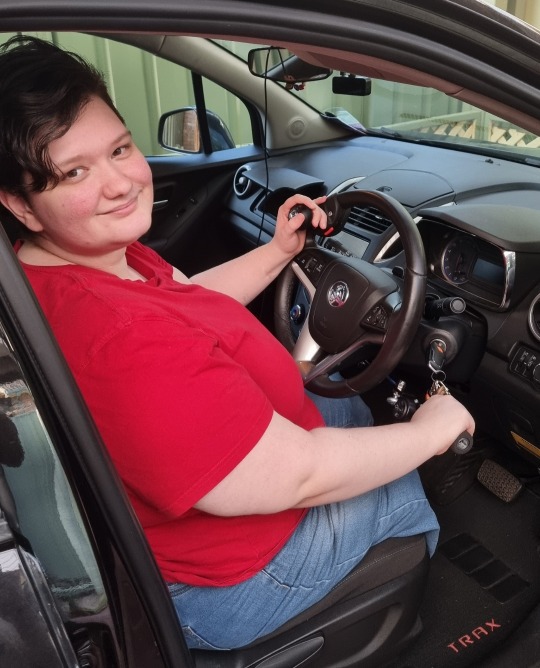
[ID: A photo of cy, a white nonbinaru person with brown hair, wearing a red shirt and no legs. They are sitting behind the wheel of a car with modifications so that they can control the pedals with a lever next to the steering wheel. /end Id]
#and it only took 6 months of arguing with insurance that they are legally responsible for replacing them lol#disability#disabled#hand controls#accessibility#wheelchair user
51 notes
·
View notes
Text
Someone on my mother's soaps is relearning to drive after a stroke and they're using hand controls very similar to the ones I use and it got me weirdly excited
#they're not exactly the same but like#it's just nice to see#disability accommodations#disabled driver#hand controls
12 notes
·
View notes
Text

YALLSTARION
I've seen too much edits of yallstarion... yes.
#astarion#bg3 astarion#astarion ancunin#bg3 art#bg3 fanart#bg3#baldurs gate 3#yallstarion#myart#My hands are out of my control#thats pretty self explanatory.
9K notes
·
View notes
Text













[first] | [prev] | [next]
pnf revival challenge day 18: Phineas!
Hosted by @howtonerdoutovereverything! ✨
I DIDNT MEAN TO LIE, I HAD NO PLANS OF CONTINUING THIS REVEAL THREAD AT ALL , DIRECTLY OR NOT, BUT THEN i dont know what happened and now i cant even say i wont continue it because i know for a fact ill try to get a some sorta ferb POV on the situation too hsdfugihgudsf
anyway this happens the same day as the reveal from day 9, just later at night, theyre all good, they talked it out by now but its still awkward i gUESS 🤷♂️
#head in hands i have no control of whats going on anymore#all my comics are interconnected and i have no say in the matter#its so hard to put the feelings i had in mind into still images i had to fight myself to not animatic again shdfguifdhgs#kad draws#phineas and ferb#pnf#pnfrevivalchallenge#phineas flynn#perry the platypus#linda flynn fletcher
3K notes
·
View notes
Text

Realized I have not posted in awhile goooo my attempt at human loop doodles
#orangetriestoart#isat spoilers#2hats spoilers#hhhHhhHhHh I feel like I haven’t drawn im forever I’m so rustyyyyyyyy#but anyways going on a short ramble I love the idea of loop getting picked up by a house of change post 2hats and finding themselves again#I think they’d purposely wear loose clothing to hide the leftover effects of wishcraft also it’s just comfier n less effort#something something i also like the idea of them growing their hair out post loops cause it’s just another way to separate the#from who they used to be ahaha but they do not maintain it so it gets way messier than it was before#but like maybe after awhile they learn to take care of it properly and have fun with it and change it up because wow#its something they can actually have control over! it’s fully theirs!#idk I’m not a writer dhigkhshkgshkgs#also realizing I forgot to go back and finish the hand in the first one whoopsie#anywaysssss have a good day/night tumblr void a a a a. a a a
1K notes
·
View notes
Text

Black Mercy
#my adventures with superman#maws#maws spoilers#clark kent#superman#brainiac#jor el and lara are holding kid clark's hands but they're just hands so im not tagging them#posting my sketches so i actually post. dont look too closely at the lines pls thank youuu#cant believe this is my first MAWS fanart. the first superheo fanart im posting. and its THIS OUTFIT#This fit was for the girls and the gays ok- im doing my duty as a tumblr user ok i swear please im so normal about this episode-#black mercy is the thing that lets clark be mind controlled. also this is evil mind controlled clark for ppl who dont watch MAWS#my art
3K notes
·
View notes
Text
One day, someone makes the mistake of mentioning Kate's wife when she's on the field and Gaz, Ghost and Soap expect her to be fine.
John knows better.
It takes John, Ghost, and Soap between them, with Gaz holding a hand over the guys mouth to stop Kate from genuinely being at risk of killing him. John actually lifts her off of the ground and walks out with her kicking and fighting to get out of his grip.
Ghost has to guard the door when he drags her out, Soap and Gaz can be heard getting a little hands-on with their interrogation. John’s grip on Kate is so tight that she'll undoubtedly bruise, but she'll forgive him when he stops her from losing her job.
"Kate- Kate, stop fucking- CALM DOWN- Think about it, it's a scare tactic. Sarah is at home with the cats, and she's fine, he wouldn't tell you about it if he wasn't going to touch her. She's alright."
"You don't fucking know that, you've seen the pictures, John. You know what he does to people-"
"Kate, calm down. Call her, phone Sarah right now and listen to her voice. She's fine, you'll be fine."
Even Simon has an undeniable picture of Laswell in her head. She's unshakeable, she's calm and she's fucking funny when she feels like it. But he's never seen this before, she's downright vicious and he can't help but watch with wide eyes as John grabs her phone out of her pocket and forces it into her hands. Can't help how his lip twitches into a frown that none of them can see as her voice shakes when she talks down the phone to her wife. How she slumps against Price and he holds her up, muttering quietly to her as her wife's voice speaks through the phone.
"She's fine. You're fine. He's a lying git, Kate. Nothing's going to happen to Sarah, you'd never allow it and neither would I. Hell, neither would Nik. The big bugger loves her."
Simon knows better than anyone that they're all human, despite all the rumours and the hero worship everyone gazes at them with. They're people. But sometimes even he forgets that Kate Laswell isn't a Station Chief, she's a woman with a wife at home and a group of cats that John likes laughing at pictures of. It's for that reason that he looks away, offers her the dignity of calming down in peace and slipping back into the Watcher persona without his eyes on her.
He pointedly ignores the grateful look John shoots him.
#captain john price#kate laswell#laswells wife#john soap mactavish#simon ghost riley#kyle gaz garrick#cod nikolai#sorry you cn rip best friends kate and john from my cold dead hands#she is not immune to freaking out over her wife and he is more than willing to play impulse control for a few minutes#if kate freaks out on the field then you run shoot or find john price urgently#also nikolai and kates wife are friends and if you dont agree then idc this is my post#oc: sarah laswell
2K notes
·
View notes
Text

(Sept) Don't do it, she's just using you to get past the first boss
#don't mind the left handed controller#i flipped the pic at the last minute so the words are on the left but didn't double check
2K notes
·
View notes
Text




THE HEART KILLERS (2024) I EP. 2 "I like your name, by the way. Fadel."
#the heart killers#the heart killers the series#thk#dunk natachai#joong archen#joongdunk#fadel x style#fadelstyle#kantbison#uservix#userfaiza#userrlaura#userrlana#userspicy#usermor#fyeahthaidramas#tuseryoo#thai bl#asiandramanet#hats off to joong's acting#the way he portrayed that pent-up frustration that only came to the surface when fadel was alone with his own thoughts#to think that a man as cold and controlled as fadel could be driven to biting down on his own hand while doing that - insane!!!#if style ever finds out about this fadel is never gonna hear the end of it#also love how joong even this scene has shown how conflicted fadel is while he's giving into the pleasure#and omg the contrast in the lighting of the reality and the fantasy - i love it so much#style is surrounded by warm colors while fadel is alone in a dark room#mywork
1K notes
·
View notes
Text

Maybe we never had a chance.
[First] Prev <–-> Next
#poorly drawn mdzs#mdzs#wei wuxian#lan wangji#a-yuan#Ultimately...despite how hard we try to reach people - sometimes it just is not possible.#Sometimes all you can do is wish that things could have been different. You pen a note with all the things you want to say -#and then you let it go. The words stay unsent and unspoken. You just watch the rift between you grow until you're too far away to try again#It is a sad end! It is two people who want to be closer but do not have the right capacity to do anything but shut doors.#Worse yet; it's two people who feel it is not their place to try and impose anything more.#It takes so long to heal from endings like that. You never get enough closure when there is still a faint hope of 'another day'.#It's a false amicability. It's closing a door and telling yourself that at least the windows are unlocked.#WWX will keep up his friendliness as a way to hold LWJ at a distance. LWJ can only try to help so many times.#Speaking of tragedies of trying to help; Let's talk about the addiction metaphors in this episode.#WWX tells LWJ in fairly straightforward terms that he does not *want* do be doing ghost cultivation.#What he wants is to protect people - by any means necessary. If he had another option he would take it.#The path WWX 'chose' is one that is deeply mired in external shame and taboo. He jokes about it but it clearly doesn't feel great.#And I put 'chose' in quotes because just like many who find them selves in bad situations - the choice is an illusion.#He's adamant that this is 'his' choice. That he is in control.#Better to be villainized that endure the terrifying reality that you lack any ability to have choice anymore.#If he had the choice - truly had the choice - he would not be doing this.#You can't help those who don't want to be helped. So of course all LWJ can do is watch from the side. Offer a hand when he can.#This life was a tragedy and the countdown to it all blowing up started a long time ago...
1K notes
·
View notes
Text




Quick sketch comic of these two being...these two.
Their love languages are Acts of Violence, Words of Agitation, Brutality Time, Trading Blows, and Physical Assault.
#like can they PLEASE be normal yeesh#i love how they're genuinely just freak for freak violent fighter against violent fighter#you'd think it was Leigh's in her Grinning Beast form that took me the longest to sketch out but nope it was them kissing in the first one#I wanna clean that sketch up and turn it into a sticker :)#I think that'd be nice#sketches#fanart#look outside#look outside fanart#look outside leigh#leigh look outside#look outside hellen#hellen look outside#hellen x leigh#HELLEIGH FANS COME GETS YA'LLS FUCKED UP JUICE#you can pry my “Leigh can control the level and rate at which she transforms into the Grinning Beast” headcanon from my cold dead hands#crunchy art#Who Let Soup Outside?
767 notes
·
View notes
Text
why kris is going to lose their hand
so ive seen people talk about all the foreshadowing about kris potentially losing their hand such as:
[image link credit]

and for quite a while i was wondering WHY they would possibly lose their hand. toby wouldn't do it for no reason just to add #angst
and then it hit me.

the only way for kris to remove their soul is by using their hands. every single cutscene we've seen where they take the soul out has them violently digging into themselves and tearing it out. and we can see in the prophecy image that there is the soul and two hands. highlighting the only parts the prophecy deems important.
i think a potential reason for kris losing their hands is because someone would want to stop them from taking their soul out so they cant regain their autonomy and control. as to why or who would want to stop kris from doing this is extremely unclear to me (maybe someone like gaster if he is running this whole weird experiment on it??? idk) - but this is one of the only reasons i think that would make sense. you could argue that yes they technically could still take it out with their other hand but i dont think theyd want to risk losing BOTH hands in such a situation and it would at least prevent them taking it out for the time being
the other option ive thought about is actually that they remove it THEMSELVES in act of desperation or defiance against the player. this could potentially happen in good/neutral route but i think this would actually be much more appropriate for the weird route. kris already has a history of self-harm in relation to acting out against the player, and i can see them doing something so drastic in the weird route so that that player cant use their body, their hands, to hurt anyone they love anymore.
so that we don't have another repeat of this.

#and before people say we've seen the soul without kris ripping it out it isnt the same#when we see the soul hovering we're still in control of kris#the only time they truly have their own autonomy is the scenes where they rip it out with their own two hands#deltarune#deltarune spoilers#kris dreemurr#deltarune theory
472 notes
·
View notes
Text
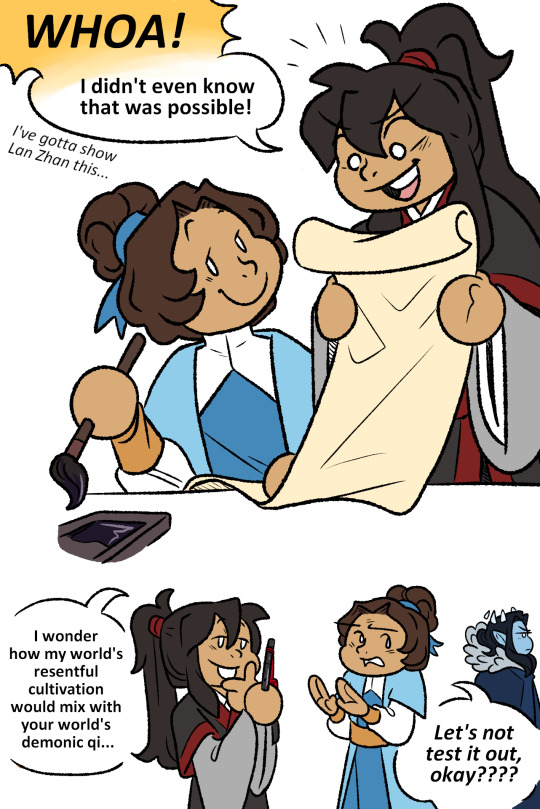

@ladyprophet thank you!! (,,> ᴗ <,,)
I feel like SQH's quality of writing would be right up WWX's alley - kinda trashy, kinda hilarious, very horny! he would very happily follow along with all new chapter updates! on the other hand WWX's willingness to do completely insane things with no sense of self-preservation would probably be stressing SQH out a bit xD
#mdzs#svsss#shang qinghua#wei wuxian#mobei jun#sqh#wwx#mbj#mxtx#my art#svsss's demonic qi does sound like a very different system than mdzs's resentful energy#though the idea of wwx attempting to control a svsss demon and it working to a greater or lesser degrees is hilarious to me#there would be some Very Fucking Unhappy Demons Who Would Like To Have Words very quickly#on the other hand i DO think wwx's cultivation could affect the ghosts in tgcf and that's a headcanon/au/thought i like to play with a lot#though imagine wwx looking over some of the gratuitous violence like#''that's not what it sounds like when a hand is thrust through someone's rib cage though just saying...''#sqh eyeballing his silly goofy friend who doesn't even carry a sword: ......what????
916 notes
·
View notes
Text


gotta get some fishing practice in before may starts... gonna catch a mermaid and host a bbq
#my art#daycare attendant#sundrop#sunnydrop#moondrop#idk if sun has the patience for fishing#and idk if moon has the self control needed to not leap into the water to try to catch a fish with it's bare hands#however it'd be good for them. this would be the ideal retirement plan#they also look really funny in the outfit so i'll be sure to think of an excuse to make this happen#it's not shown here but please also picture them in khaki shorts with socks and sandals. thank you
429 notes
·
View notes